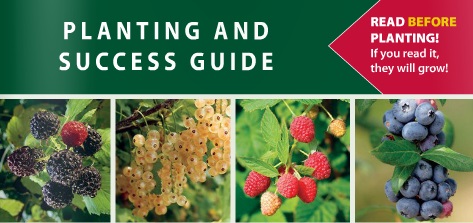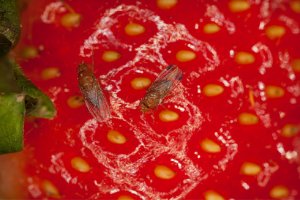Prevention • Detection • Control
Strawberries and brambles can be attacked by a range of pests including insects, pathogens and weeds. An important factor in controlling pests is the ability to maintain healthy plants and where starting out with a good site is critical. Keeping on top of pest levels, particularly Insects, through scouting and subsequent control allows you to manage a problem before it becomes serious.
SITE SELECTION
Preparations for small fruit plantings should begin at least one year in advance. A nutritionally healthy planting in a well-drained soil with exposure to air movement is less susceptible to damage from pests and frosts. Small fruit crops need good internal soil drainage to grow and do best on a well-drained sandy loam. Wet soils restrict root growth and respiration, resulting in weak growth and reduced yields. Planting on raised beds is useful to improve soil drainage in the rooting zone, particularly on heavier soils. Air drainage is an important consideration in choosing a field site. Cold air, like water, runs downhill, and collects in low areas or areas where trees or hedgerows obstruct airflow. These ‘frost pockets’ increase the risk of both mid-winter cold injury and spring frost damage, putting the plants under stress which can make them more susceptible to pests. Selecting a site with a gentle slope (3-4%) and good air drainage will also reduce this risk. Good air drainage will also promote faster drying of foliage, flowers and fruit which will reduce the duration and frequency of disease infection periods.
SCOUTING
A key component of a successful pest management program is developing a well-orchestrated scouting strategy. A scouting strategy to determine their presence during bloom period could help growers prevent crop loss from their mass migration. We recommend growers begin to plan a scouting routine that will begin the day mulch is removed from the plants. Plan to visit or have your field visited at least 1 time per week during the entire season. During blossom and fruit set seriously consider scouting twice per week. Have a check list in hand that identifies possible pests so that no pest goes unchecked. For identification, there are a variety of excellent tools including free phone apps such as MYIPM -SED and MYIPM-SEP. If you are not planning to do scouting, then consider putting a spray program into place to control insects. Flower thrips and tarnished plant bug are the two critical pests along with strawberry clipper.
KEY PESTS
• Flower Thrips - For several strawberry seasons in a row, many growers have seen crop damage due to Flower Thrip infestations. Flower Thrip damage is very similar to Tarnished Plant Bug, where fruit are misshapen, damaged or ‘Cat Face’. In some instances, the Flower thrips took the entire crop due to extensive damage. A scouting strategy to determine their presence during bloom period, can help growers prevent crop loss from their mass migration. Several insecticides labeled for use on strawberries are effective on thrips. Again, as thrips can cause extensive damage, if you are not going to scout, consider making preventative insecticide applications for control. Consult your local Cooperative Extension office for state recommendations.
• Cane Blight and Cane Botrytis - Due to last year’s wet conditions cane blight and cane botrytis could be more prevalent this spring. Cane blight and cane botrytis are serious diseases in brambles that display as dark brown to purple cankers on the main canes or branches, and can extend several inches along the cane. The risk of cane blight is greatly increased when primocanes are injured or improperly pruned. Although pruning cuts provide a major infection site, insect damage, herbicide damage, and winter injury can also be infection sites. In many cases, cane blight is located at the base of the canes where they were wounded by old canes. Once fruit canes are inoculated, it is necessary to spray fungicides to prevent infections to the primocanes. However, established infections on fruiting canes can’t be removed or cured by fungicide sprays as most are protective, not curative. Proper removal of fruiting canes and application of effective chemicals together with cultural practices that minimize injury on canes play an important role in managing the disease.
• Black Root Rot Complex - Black root rot is the general name for several root disorders that product similar symptoms. The disorders are not clearly understood and are generally referred to as root-rot complex. Our wet conditions this past season could precipitate more black root rot symptoms that usual. The exact cause of the black root rot is thought to be a combination of several soil fungi (such as Rhizoctonia, Pythium, Phytophthora and Fusarium) as well as nematodes, winter injury, fertilizer burn, soil compaction and saturated soils. Incidences of black root rot have increased, particularly in the last 2-3 years and more on heavier, clay-type soils due to the high moisture levels. Roots affected by black root rot are smaller than normal overall, main roots are spotted with dark patches or in sever cases, all or part is dead. Feeder roots are lacking or spotted with dark patches or zones. All lead to the appearance of black “rat-tail” like roots. Crop rotation and fungicide/Oxidate dip are your first line of defense for this complex as there is little controls available once it is established.
• Phytophthora Root Rot - Considered the # 1 enemy of raspberries, the wet conditions of this last season saw an above average incidence of Phytophthora Root Rot, especially on heavier soils and in low-lying areas of fields that are slow to dry. Given that there is very little resistance available in varieties, your best line of defense is good, sound cultural practices -- most importantly, the use of raised beds. These practices start out with a soil rotation plan where you avoid planting back into a prior raspberry site for at least 2- 3 years. Secondly, planting on well drained soils using raised beds is a good management step to increase drainage in the root zone, particularly for organic growers. For conventional growers, the use of soil fungicide drenches in the spring and fall of Ridomil Gold and Phosphate type materials are helpful in the control of Phytophthora Root Rot.
• Spotted Wing Drosophila (SWD) - Growers continue to battle with this pest that becomes more problematic as the summer season progresses. SWD Basics:
1. Most state extension departments are wellschooled in Spotted Wing Drosophila identifi cation and potential control. We strongly encourage you to seek out resources in your area. For specific pest control recommendations, consult your local cooperative extension office for specific state recommendations.
2. Monitor with traps to know when present.
3. Timing of insecticide sprays begin with first color. Maintain 5-7-day crop protectant application along with a frequent picking schedule.
4. Cultural controls include removal of cull fruit from field and harvesting all ripe fruit every picking.
5. Deliver harvested fruit to the cold storage hourly, maintaining temperatures as close to 32’ F as possible.
For more detailed information, below are 2 excellent resources for information:
http://extension.umass.edu/fruitadvisor/spotted-wingdrosophila
UMass Extension offers an excellent monthly newsletter that includes several informative articles on small fruit production.
https://www.canr.msu.edu/ipm/invasive_species/spotted_wing_drosophila/




